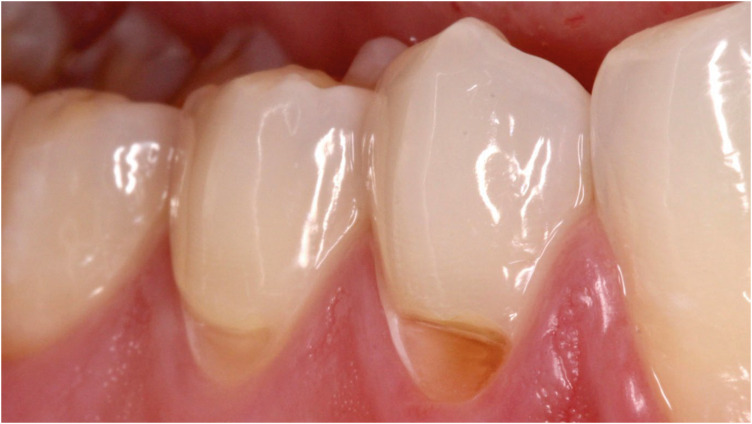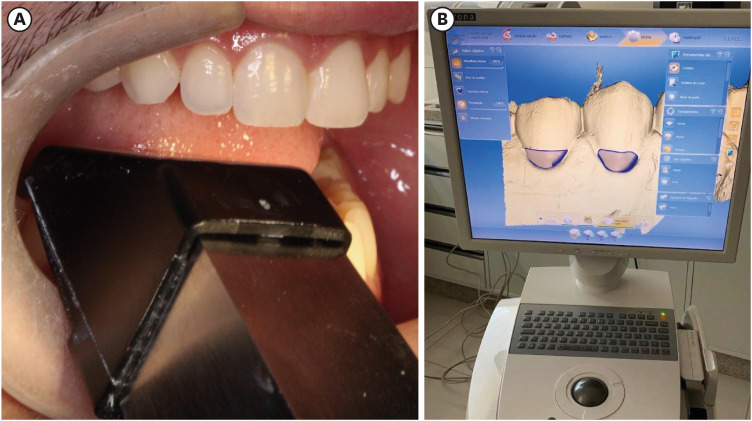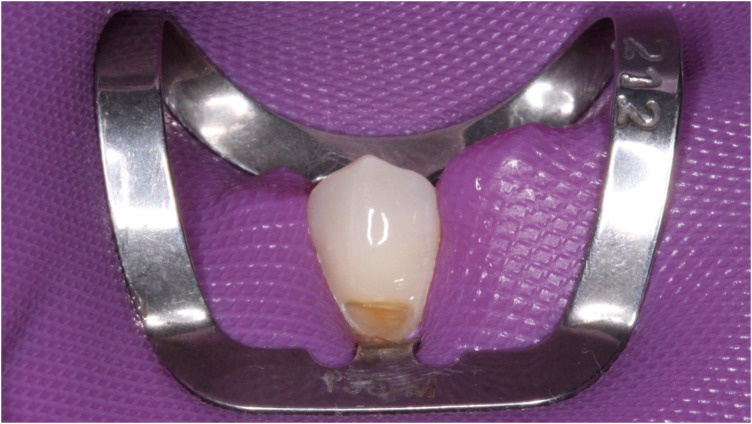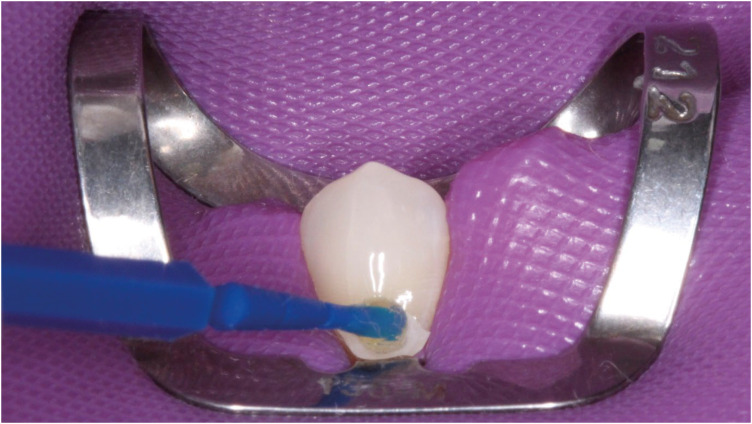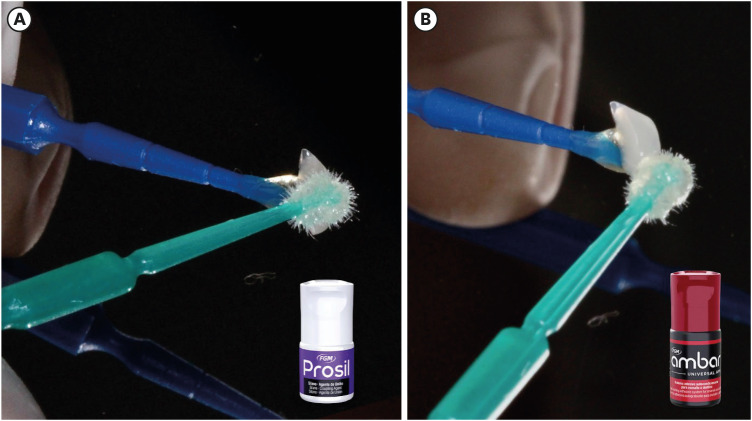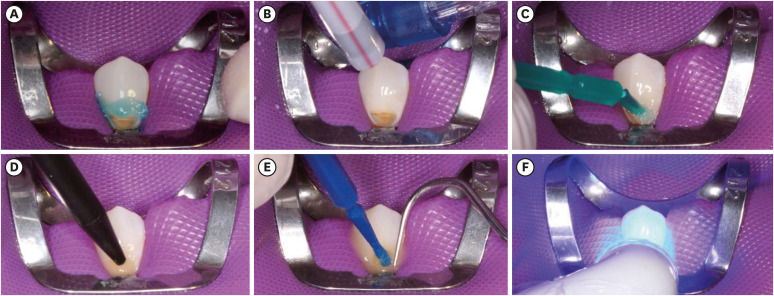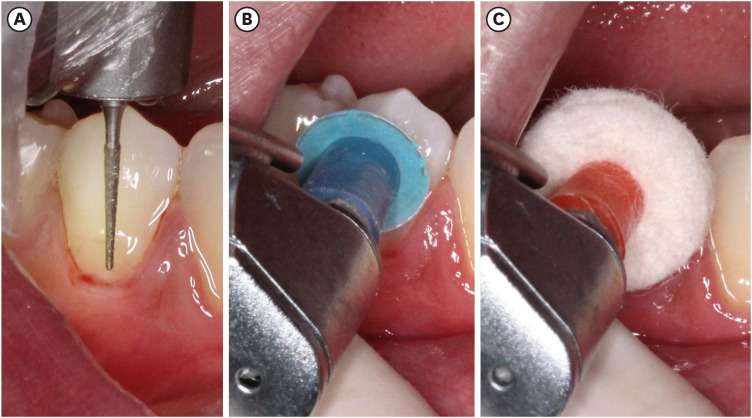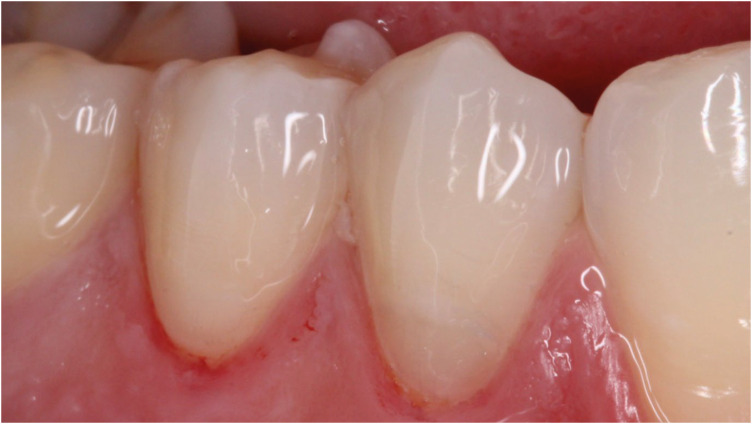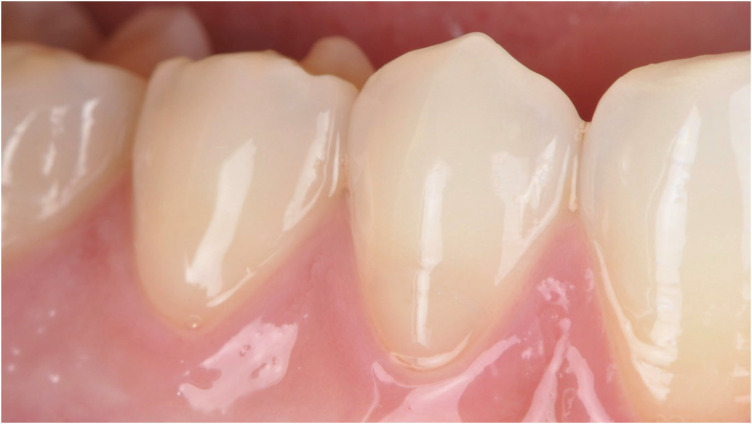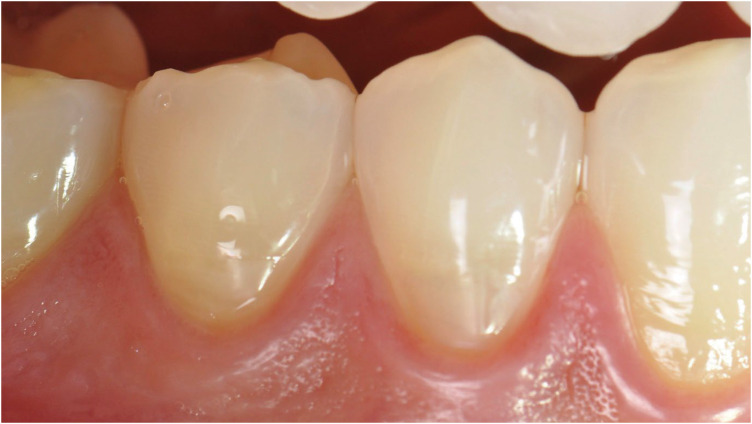Restor Dent Endod.
2024 Aug;49(3):e32. 10.5395/rde.2024.49.e32.
A 48-month clinical performance of hybrid ceramic fragment restorations manufactured in CAD/CAM in noncarious cervical lesions: case report
- Affiliations
-
- 1Department of Restorative Dentistry, State University of Ponta Grossa, Ponta Grossa, PR, Brazil
- 2Department of Restorative Dentistry, Tuiuti University of Parana, Curitiba, PR, Brazil
- 3Department of Restorative Dentistry, Paranaense University Francisco Beltrão, Francisco Beltrão, PR, Brazil
- KMID: 2559745
- DOI: http://doi.org/10.5395/rde.2024.49.e32
Abstract
- From the restorative perspective, various methods are available to prevent the progression of non-carious cervical lesions. Direct, semi-direct, and indirect composite resin techniques and indirect ceramic restorations are commonly recommended. In this context, semidirect and indirect restoration approaches are increasingly favored, particularly as digital dentistry becomes more prevalent. To illustrate this, we present a case report demonstrating the efficacy of hybrid ceramic fragments fabricated using computer-aided design (CAD)/ computer-aided manufacturing (CAM) technology and cemented with resin cement in treating non-carious cervical lesions over a 48-month follow-up period. A 24-year-old male patient sought treatment for aesthetic concerns and dentin hypersensitivity in the cervical region of the lower premolar teeth. Clinical examination confirmed the presence of two non-carious cervical lesions in the buccal region of teeth #44 and #45. The treatment plan involved indirect restoration using CAD/CAM-fabricated hybrid ceramic fragments as a restorative material. After 48 months, the hybrid ceramic material exhibited excellent adaptation and durability provided by the CAD/CAM system. This case underscores the effectiveness of hybrid ceramic fragments in restoring non-carious cervical lesions, highlighting their long-term stability and clinical success.
Keyword
Figure
Reference
-
1. Teixeira DNR, Thomas RZ, Soares PV, Cune MS, Gresnigt MMM, Slot DE. Prevalence of noncarious cervical lesions among adults: a systematic review. J Dent. 2020; 95:103285. PMID: 32006668.2. Warreth A, Abuhijleh E, Almaghribi MA, Mahwal G, Ashawish A. Tooth surface loss: a review of literature. Saudi Dent J. 2020; 32:53–60. PMID: 32071532.3. Duangthip D, Man A, Poon PH, Lo ECM, Chu CH. Occlusal stress is involved in the formation of non-carious cervical lesions. A systematic review of abfraction. Am J Dent. 2017; 30:212–220. PMID: 29178704.4. Yan J, Xie W, Zhang L, Wang J, Wang J, Liu K, et al. Low torque is a risk factor for non-carious cervical lesions (NCCLs) in maxillary premolars. Am J Dent. 2021; 34:245–249. PMID: 34689446.5. Fahl N Jr. Direct-indirect class v restorations: a novel approach for treating noncarious cervical lesions. J Esthet Restor Dent. 2015; 27:267–284. PMID: 26031691.6. Durán JC, Alarcón C, De la Jara D, Pino R, Lanis A. Multidisciplinary treatment of deep non-carious cervical lesion with a CAD/CAM chairside restoration in combination with periodontal surgery: a 60-month follow-up technique report. Clin Adv Periodontics. 2021; 11:87–92. PMID: 33569921.7. Staninec M, Tsuji G. Restoration of non-carious cervical lesions with ceramic inlays: a possible model for clinical testing of adhesive cements. Dent Hypotheses. 2012; 3:155–158.8. Fathy H, Hamama HH, El-Wassefy N, Mahmoud SH. Clinical performance of resin-matrix ceramic partial coverage restorations: a systematic review. Clin Oral Investig. 2022; 26:3807–3822.9. Alharbi A, Rocca GT, Dietschi D, Krejci I. Semidirect composite onlay with cavity sealing: a review of clinical procedures. J Esthet Restor Dent. 2014; 26:97–106. PMID: 24341472.10. Azarbal A, Azarbal M, Engelmeier RL, Kunkel TC. Marginal fit comparison of CAD/CAM crowns milled from two different materials. J Prosthodont. 2018; 27:421–428. PMID: 29143397.11. de Paris Matos T, Wambier LM, Favoreto MW, Rezende CEE, Reis A, Loguercio AD, et al. Patient-related outcomes of conventional impression making versus intraoral scanning for prosthetic rehabilitation: a systematic review and meta-analysis. J Prosthet Dent. 2023; 130:19–27. PMID: 34756424.12. Joda T, Zarone F, Ferrari M. The complete digital workflow in fixed prosthodontics: a systematic review. BMC Oral Health. 2017; 17:124. PMID: 28927393.13. Brignardello-Petersen R. There seem to be similar outcomes when restoring noncarious cervical lesions with direct or semidirect techniques after 2 years. J Am Dent Assoc. 2020; 151:e4. PMID: 31703804.14. Caneppele TMF, Meirelles LCF, Rocha RS, Gonçalves LL, Ávila DMS, Gonçalves SEP, et al. A 2-year clinical evaluation of direct and semi-direct resin composite restorations in non-carious cervical lesions: a randomized clinical study. Clin Oral Investig. 2020; 24:1321–1331.15. Ekici MA, Egilmez F, Cekic-Nagas I, Ergun G. Physical characteristics of ceramic/glass-polymer based CAD/CAM materials: effect of finishing and polishing techniques. J Adv Prosthodont. 2019; 11:128–137. PMID: 31080574.16. Boing TF, de Geus JL, Wambier LM, Loguercio AD, Reis A, Gomes OMM. Are glass-ionomer cement restorations in cervical lesions more long-lasting than resin-based composite resins? A systematic review and meta-analysis. J Adhes Dent. 2018; 20:435–452. PMID: 30349908.17. Mahn E, Rousson V, Heintze S. Meta-analysis of the influence of bonding parameters on the clinical outcome of tooth-colored cervical restorations. J Adhes Dent. 2015; 17:391–403. PMID: 26525003.18. Paula AM, Boing TF, Wambier LM, Hanzen TA, Loguercio AD, Armas-Vega A, et al. Clinical performance of non-carious cervical restorations restored with the “sandwich technique” and composite resin: a systematic review and meta-analysis. J Adhes Dent. 2019; 21:497–508. PMID: 31802065.19. Bustamante-Hernández N, Montiel-Company JM, Bellot-Arcís C, Mañes-Ferrer JF, Solá-Ruíz MF, Agustín-Panadero R, et al. Clinical behavior of ceramic, hybrid and composite onlays. A systematic review and meta-analysis. Int J Environ Res Public Health. 2020; 17:17.20. Riley DS, Barber MS, Kienle GS, Aronson JK, von Schoen-Angerer T, Tugwell P, et al. CARE guidelines for case reports: explanation and elaboration document. J Clin Epidemiol. 2017; 89:218–235. PMID: 28529185.21. Hickel R, Mesinger S, Opdam N, Loomans B, Frankenberger R, Cadenaro M, et al. Revised FDI criteria for evaluating direct and indirect dental restorations-recommendations for its clinical use, interpretation, and reporting. Clin Oral Investig. 2023; 27:2573–2592.22. Alvarez-Arenal A, Alvarez-Menendez L, Gonzalez-Gonzalez I, Alvarez-Riesgo JA, Brizuela-Velasco A, deLlanos-Lanchares H. Non-carious cervical lesions and risk factors: a case-control study. J Oral Rehabil. 2019; 46:65–75. PMID: 30252966.23. Coldea A, Swain MV, Thiel N. Mechanical properties of polymer-infiltrated-ceramic-network materials. Dent Mater. 2013; 29:419–426. PMID: 23410552.24. Peumans M, De Munck J, Mine A, Van Meerbeek B. Clinical effectiveness of contemporary adhesives for the restoration of non-carious cervical lesions. A systematic review. Dent Mater. 2014; 30:1089–1103. PMID: 25091726.25. Marchesi G, Camurri Piloni A, Nicolin V, Turco G, Di Lenarda R. Chairside CAD/CAM materials: current trends of clinical uses. Biology (Basel). 2021; 10:1170. PMID: 34827163.26. Andrade ACM, Borges AB, Kukulka EC, Moecke SE, Scotti N, Comba A, et al. Optical property stability of light-cured versus precured CAD-CAM composites. Int J Dent. 2022; 2022:2011864. PMID: 35685910.27. Beyabanaki E, Eftekhar Ashtiani R, Feyzi M, Zandinejad A. Evaluation of microshear bond strength of four different CAD-CAM polymer-infiltrated ceramic materials after thermocycling. J Prosthodont. 2022; 31:623–628. PMID: 34890485.28. Della Bona A, Corazza PH, Zhang Y. Characterization of a polymer-infiltrated ceramic-network material. Dent Mater. 2014; 30:564–569. PMID: 24656471.29. Motevasselian F, Amiri Z, Chiniforush N, Mirzaei M, Thompson V. In vitro evaluation of the effect of different surface treatments of a hybrid ceramic on the microtensile bond strength to a luting resin cement. J Lasers Med Sci. 2019; 10:297–303. PMID: 31875122.30. Spitznagel FA, Scholz KJ, Strub JR, Vach K, Gierthmuehlen PC. Polymer-infiltrated ceramic CAD/CAM inlays and partial coverage restorations: 3-year results of a prospective clinical study over 5 years. Clin Oral Investig. 2018; 22:1973–1983.31. Castro EF, Azevedo VLB, Nima G, Andrade OS, Dias CTDS, Giannini M. Adhesion, mechanical properties, and microstructure of resin-matrix cad-cam ceramics. J Adhes Dent. 2020; 22:421–431. PMID: 32666069.32. Lucsanszky IJR, Ruse ND. Fracture toughness, flexural strength, and flexural modulus of new CAD/CAM resin composite blocks. J Prosthodont. 2020; 29:34–41. PMID: 31702090.
- Full Text Links
- Actions
-
Cited
- CITED
-
- Close
- Share
- Similar articles
-
- Marginal fit of the digident CAD/CAM zirconia ceramic crowns
- Endocrown restorations for extensively damaged posterior teeth: clinical performance of three cases
- How adjustment could affect internal and marginal adaptation of CAD/CAM crowns made with different materials
- Six-year clinical performance of lithium disilicate glass-ceramic CAD-CAM versus metal-ceramic crowns
- Color stability of fully- and pre-crystalized chair-side CAD-CAM lithium disilicate restorations after required and additional sintering processes


